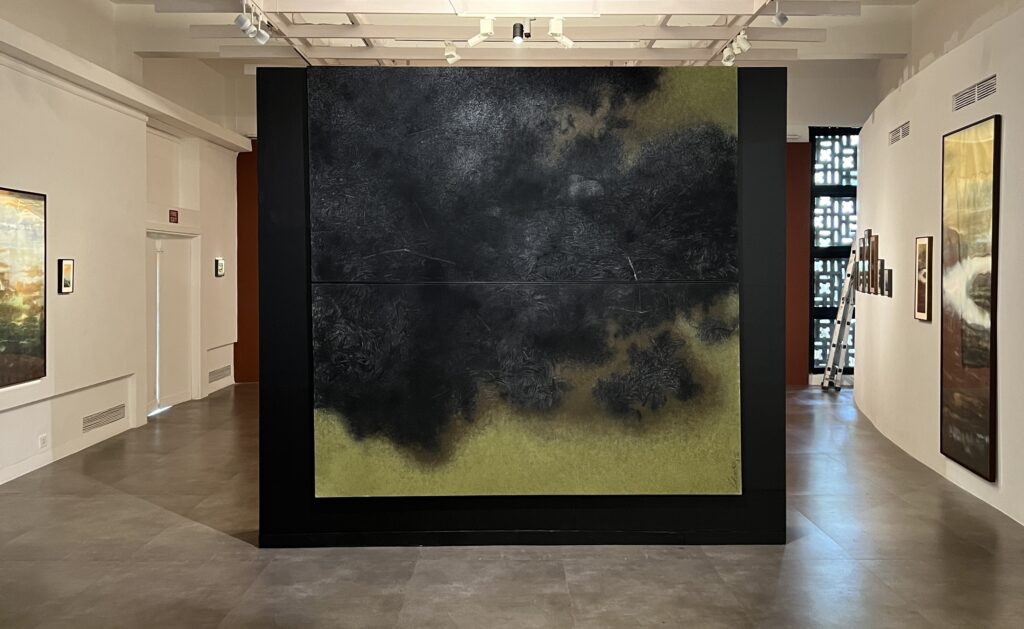by Gopika Pattiyil
Landscapes – the primary and pure expression of visual art that is evoked from even a child’s mind. An artist manifests a soul onto the strokes of paint that recreates waves, grasslands, deserts, civilizations and innumerable other existence on earth; and this act becomes magical to get interpretations that differ with people and period.
‘Impression, Sunrise’ by Monet might be a perfect painting of the sea and the sun for a lot of us, for some it might be a revolution in the world of art, and for some it might be a therapeutic and tranquil patch of brush strokes. Hence, landscapes have always been an inspiring mode of creation, confidently carrying a deep meaning that becomes flexible to the viewer.
In the era of contemporary art, Pankaj Chouhan chooses to paint landscapes to channelise his idea of home. With watercolour as his main media, the artist also uses several organic materials such as dried flowers and grasses; sand and dry pigments to create art.
Journey
Pankaj’s journey towards art begins in his childhood. He was born in 1989 in Nalanda, where he was welcomed by an innocent rural childhood, surrounded by farmlands. His shift to a much urban setting of Ranchi for better opportunities affected him, creating a sense of loss. This indeed took the form of art where he began recreating the home he always found peace in.
During his time in Jamia Millia Islamia, Pankaj discovered watercolour as his most comfortable medium to express himself, and the most suitable for his subject. The quick results the medium delivered attracted the artist, and gradually developed a deep emotional bonding with the medium itself.
“ I believe I have strong emotional bonding with watercolours. I use other mediums such as sand and other organic materials just to challenge myself” – the artist says.

Style
With the choice of a mild palette of colours and brush strokes that merge with one another, Pankaj Chouhan evokes recreated frozen moments of Indian village landscapes. His non-figurative rendition often evokes a sense of silence. Farmlands, in various seasons, from multiple unseen angles make their appearance in Pankaj’s works. By understanding the qualities of the medium deeply, the artist creates a play of light and shadow on his planes, with an enormous realisation of the principles of reflection.
However, recent works such as Left Behind-VI of Pankaj show an inclination towards geometric abstraction, where the lines and shapes become prominent against a plain background. According to him, it is how he has entered a phase of simplification to capture “the surreal aesthetic in landscape”.
He routes his experimentation with different mediums back to the time of Covid-19. The artist says – “The confinement we all had to undergo helped me draw myself closer to nature. I found myself inseparable from it, and it resulted in the creation of a language of geometrical shapes and simplification. I started using easily available materials like sindur, ash and cement and ochre at my home only followed by using dry colour pigments later.”

Concept
As discussed before, the source of stories that we understand through Pankaj’s artworks are set in Nalanda – his hometown. A childhood migration that he went through pulled him closer to the place he was born; he began delving more into its beauty, the vegetation, the life, and the total ecosystem he was once part of. This story of his becomes stronger with an ecological aspect attached to it.

The effect of urbanisation, with which the farmlands and grasslands of the country is depleting at a vigorous pace becomes a relevant topic he connects with his personal story. Those patches of grass where he used to play are endangered, so are the wheat fields that present surreal sights. They are now being replaced by tall concrete structures, with which the naive lives of people also change. He represents this change through his landscapes, which are often stagnant, unchanged.
Pankaj Chouhan thus connects his roots that is slowly disappearing, to an ecological question of losing rural lands of the country.
